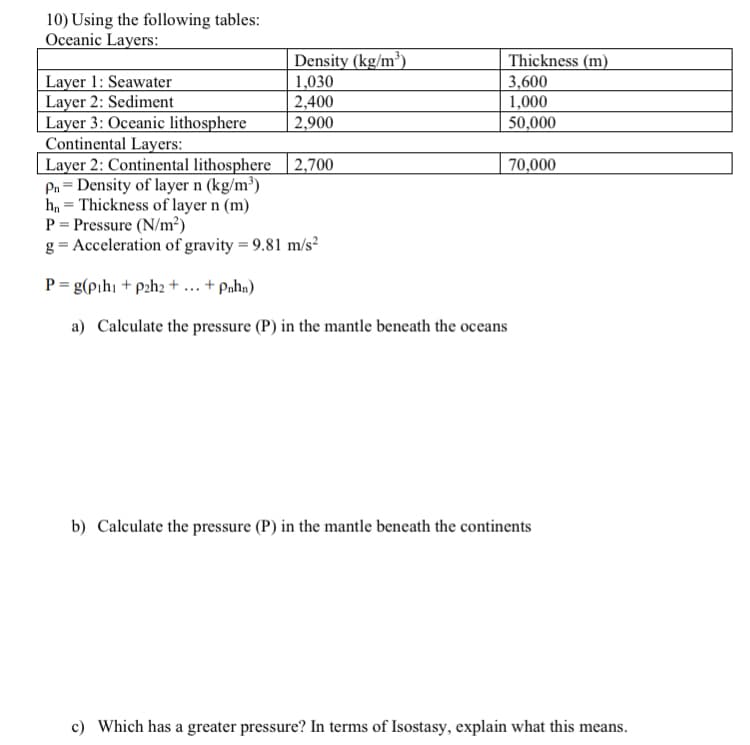10) Using the following tables: Oceanic Layers: Density (kg/m³) 1,030 2,400 Thickness (m) 3,600 1,000 50,000 Layer 1: Seawater Layer 2: Sediment Layer 3: Oceanic lithosphere Continental Layers: Layer 2: Continental lithosphere | 2,700 Pn = Density of layer n (kg/m³) h. = Thickness of layer n (m) P = Pressure (N/m²) g= Acceleration of gravity = 9.81 m/s² 2,900 70,000 P = g(pihi + pzh2 + ... + Paha) a) Calculate the pressure (P) in the mantle beneath the oceans b) Calculate the pressure (P) in the mantle beneath the continents c) Which has a greater pressure? In terms of Isostasy, explain what this means.
10) Using the following tables: Oceanic Layers: Density (kg/m³) 1,030 2,400 Thickness (m) 3,600 1,000 50,000 Layer 1: Seawater Layer 2: Sediment Layer 3: Oceanic lithosphere Continental Layers: Layer 2: Continental lithosphere | 2,700 Pn = Density of layer n (kg/m³) h. = Thickness of layer n (m) P = Pressure (N/m²) g= Acceleration of gravity = 9.81 m/s² 2,900 70,000 P = g(pihi + pzh2 + ... + Paha) a) Calculate the pressure (P) in the mantle beneath the oceans b) Calculate the pressure (P) in the mantle beneath the continents c) Which has a greater pressure? In terms of Isostasy, explain what this means.
Applications and Investigations in Earth Science (9th Edition)
9th Edition
ISBN:9780134746241
Author:Edward J. Tarbuck, Frederick K. Lutgens, Dennis G. Tasa
Publisher:Edward J. Tarbuck, Frederick K. Lutgens, Dennis G. Tasa
Chapter1: The Study Of Minerals
Section: Chapter Questions
Problem 1LR
Related questions
Question

Transcribed Image Text:10) Using the following tables:
Oceanic Layers:
Density (kg/m³)
Thickness (m)
Layer 1: Seawater
Layer 2: Sediment
Layer 3: Oceanic lithosphere
Continental Layers:
Layer 2: Continental lithosphere | 2,700
Pn = Density of layer n (kg/m³)
h, = Thickness of layer n (m)
P = Pressure (N/m²)
g = Acceleration of gravity = 9.81 m/s²
1,030
| 2,400
2,900
3,600
1,000
50,000
70,000
P = g(pihi + pzh2 + ... + Pnha)
a) Calculate the pressure (P) in the mantle beneath the oceans
b) Calculate the pressure (P) in the mantle beneath the continents
c) Which has a greater pressure? In terms of Isostasy, explain what this means.
Expert Solution
Step 1
Since you have posted a question with multiple sub-parts, we will solve the first three sub-parts for you. To get the remaining sub-part solved please repost the complete question and mention the sub-parts to be solved.
The Pressure(P) on an area can be determined by the formula . Here, is the thickness of the overlying layer.
In the case of multiple overlying layers, the formula will be , where is the number of overlying layers.
In this problem, for the mantle below oceans, the multiple overlying layer formula will be used.
Step by step
Solved in 3 steps

Recommended textbooks for you

Applications and Investigations in Earth Science …
Earth Science
ISBN:
9780134746241
Author:
Edward J. Tarbuck, Frederick K. Lutgens, Dennis G. Tasa
Publisher:
PEARSON

Exercises for Weather & Climate (9th Edition)
Earth Science
ISBN:
9780134041360
Author:
Greg Carbone
Publisher:
PEARSON

Environmental Science
Earth Science
ISBN:
9781260153125
Author:
William P Cunningham Prof., Mary Ann Cunningham Professor
Publisher:
McGraw-Hill Education

Applications and Investigations in Earth Science …
Earth Science
ISBN:
9780134746241
Author:
Edward J. Tarbuck, Frederick K. Lutgens, Dennis G. Tasa
Publisher:
PEARSON

Exercises for Weather & Climate (9th Edition)
Earth Science
ISBN:
9780134041360
Author:
Greg Carbone
Publisher:
PEARSON

Environmental Science
Earth Science
ISBN:
9781260153125
Author:
William P Cunningham Prof., Mary Ann Cunningham Professor
Publisher:
McGraw-Hill Education

Earth Science (15th Edition)
Earth Science
ISBN:
9780134543536
Author:
Edward J. Tarbuck, Frederick K. Lutgens, Dennis G. Tasa
Publisher:
PEARSON

Environmental Science (MindTap Course List)
Earth Science
ISBN:
9781337569613
Author:
G. Tyler Miller, Scott Spoolman
Publisher:
Cengage Learning

Physical Geology
Earth Science
ISBN:
9781259916823
Author:
Plummer, Charles C., CARLSON, Diane H., Hammersley, Lisa
Publisher:
Mcgraw-hill Education,